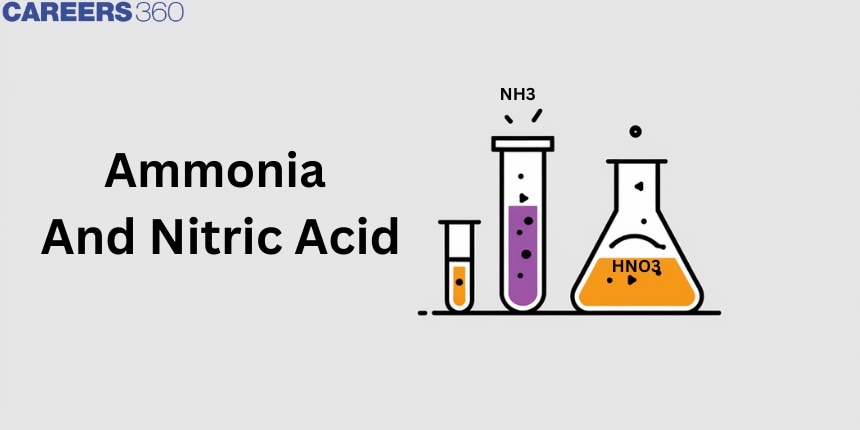Ammonia And Nitric Acid Formulae Properties Preparation: Structure, Applications, Uses, FAQs
Ammonia is one of the most commonly manufactured chemicals in the United States. It is one of the most common hydrides in the atmosphere. Ammonia present in the atmosphere is produced mainly by the decomposition of bacteria released from the nitrogen element of animals and plants. The IUPAC name for ammonia is azan. NH3 is the chemical formula for ammonia. Ammonia has different properties.
This Story also Contains
- Preparation Of Ammonia-NH3
- Ammonia Properties-NH3
- Applications Of Ammonia-NH3
- Preparation Of Nitric Acid-HNO3
- Properties Of Nitric Acid-HNO3
- Applications Of Nitric Acid-HNO3

At the beginning of the 20th century, Friedrich Wilhelm Ostwald developed a process to obtain nitric acid from ammonia. Developing nitric acid helped Germany manufacture explosives during World War II without having to import it from other countries like Chile, the chemical formula for nitric acid is HNO3.
Preparation Of Ammonia-NH3
Trace amounts of Azane/Ammonia are present in soil and air due to the decomposition of nitrogenous organic matter.
For small-scale production, ammonium salts are converted to ammonia with caustic soda.
The Haber process is used for large scale production. The steps involved in the Haberian process are:
Nitrogen and hydrogen are used as starting materials for the reaction. Impurities in the gas are removed by a process called a scrubber.
After the cleaning process, the gases are combined and passed through a compressor. The mixture is then compressed at a pressure of 200 atmospheres.
The compressed gas then passes through a converter where it is heated to a temperature of 450°C and a pressure of 200 atmospheres. Nitrogen reacts with hydrogen to form ammonia, but only about 15% of the gas is formed.
A mixture of ammonia, hydrogen and nitrogen is removed from the converter. Once liquefied in the tank, it is cooled and recovered.
Ammonia Properties-NH3
Ammonia properties are as follows:
Azane is a naturally colourless gas with a pungent odour.
Boiling at 198.4 K and 239.7 K.
This gas is soluble in water. Aqueous solutions of NH3 are weak bases because OH ions are formed.
Ammonium salts are formed in a reaction with acids.
Applications Of Ammonia-NH3
The properties of Ammonia in its aqueous state are used as a refrigerant.
Used in the manufacture of urea. Urea is an excellent nitrogen fertilizer.
Azane can be used to remove grease due to its cleaning properties.
Preparation Of Nitric Acid-HNO3
For small-scale production, this gas is produced by heating concentrated sulfuric acid with NaNO3 or KNO3. The Ostwald method is used for large-scale preparations. NH3 is catalytically oxidized by atmospheric oxygen at 500 K and 9 bar pressure in the presence of Pt/Rh as catalyst. The resulting nitrogen oxides react with oxygen to form NO2. The NO2 formed dissolves in H2O to form HNO3.
Properties Of Nitric Acid-HNO3
Colourless in nature.
The liquid boils at 84.1°C and solidifies at -41.55°C to form a white solid.
Acts as a strong acid that dissociates to form nitrate and hydronium.
HNO3 is a strong oxidant in a concentrated form.
Applications Of Nitric Acid-HNO3
It has it’s application in the production of fertilizers.
Used in the manufacture of many types of polymers, including polyamides and polyurethanes.
Nitric acid is also used primarily for cleaning precious metals such as platinum, gold and silver.
Dilute nitric acid is used in the woodwork to finish maple and pine wood and give it an aged appearance.